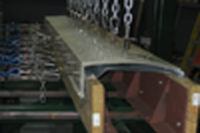When it comes to low-slope roofing specifications, it’s all about choices. Specifiers are currently faced with thousands of roof assemblies that meet code requirements. In fact, compiling a database that includes wind uplift requirements alone would be a monumental task.
But that’s exactly what the Single Ply Roofing Industry (SPRI) is planning to do. The SPRI Listing Program for IBC (International Building Code) Chapter 15 Compliance will be an industry-wide program that will contain listings from roofing material manufacturers and suppliers for IBC Chapter 15 compliance.
The benefits to designers and specifiers are many:
- Simplified listing system that allows users to search by assembly, manufacturer or other criteria.
- An accessible web-based database for verifying wind uplift resistance.
- A one-stop information source that fills many voids in current specifications.
- A listing program that is designed, created and updated by the roofing industry for the roofing industry.
It’s natural that SPRI initiated the program, as the association represents sheet membrane and component suppliers to the commercial roofing industry. Over the past several years, SPRI has developed 12 American National Standards Institute (ANSI) standards, four of which have been adopted by the IBC.
Roofing manufacturer and supplier participation in the listing program is voluntary, and specifiers may use the service free-of-charge. SPRI has chosen Intertek, a global provider of product certification and performance testing services, to oversee the program. For a fee, Intertek will ensure that manufacturer submitted listings information conforms to current IBC requirements.
Manufacturers routinely test their roof assemblies at a variety of different IBC-approved laboratories, and the program allows the submittal of reports to Intertek from any IBC-certified organization for review.
Another plus for manufacturers will be the ability for them to use the database as a repository that allows their employees to find the most up-to-date listings much quicker than they can today.
Why Wind Uplift?
SPRI’s ultimate goal is to compile an online database that includes wind uplift, fire resistance, physical properties and other IBC roof assembly requirements. However, wind performance became the primary driver for the first version of the database based on customer input and demand.
Specifically, wind resistance was chosen as the first criterion because it’s the number-one question asked by specifiers and roof consultants, according to SPRI member manufacturers and suppliers. A survey by SPRI also confirmed that having a readily accessible database on wind listings was of greater initial importance to design professionals than would be SPRI’s addressing other IBC requirements.
One of the most outstanding features of the developing database will be the ability for designers, specifiers and other users to search for specific listings based on a wide variety of roof components. Specifiers may choose to explore listings based on wind uplift rating, manufacturer, roof cover material, roof cover attachment and other components. This will make it much easier for users to target specific products for a specific wind uplift rating.
The database will include the actual tested wind uplift rating, as the IBC doesn’t include what has become industry standard “safety factors” in the requirements. Typically, a two-to-one ratio has proven to be a valid safety factor and is used by designers for most roofing projects.
So Where’s the Beta?
Considering that each major roof system manufacturer may easily have hundreds of IBC-approved roof assemblies on the books, Intertek doesn’t expect to have a beta version of the database ready until the first quarter of 2017. And that projection may be optimistic. However, it is likely that manufacturers will begin by listing their most commonly used roof assemblies, which should ease the burden on Intertek.
Once a beta is available, a group of database users that will include SPRI members, specifiers and roof consultants will determine the efficacy of the listing’s format. Intertek expects a fully-functioning database of wind resistance ratings to be available by the first quarter of 2018. At that point, SPRI’s role in the process will diminish, as Intertek sets up listings for fire and impact resistance, roof edge approvals, and more.
“Feedback from our members has been positive,” says SPRI President Jim Rubenacker. “In time, as the roofing industry sees and uses the database, our member participation and the quantity of listings each one provides will increase.”




